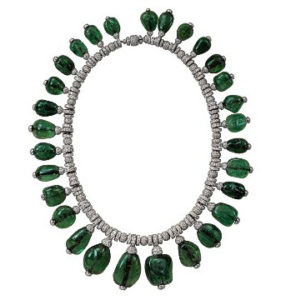What gemstone has increased in price by a factor of 10 since 2009 and is expected to jump another 25% this year with predictions of capturing up to 20% of diamond’s market share over the next 20 years? According to an article on CNN.com it’s Emerald.
Treasured by Royalty and the wealthy since the days of Cleopatra, Emerald is twenty times rarer than diamonds. Fine large Emeralds command very high prices. Recently a stunning Emerald and Diamond necklace from the collection of Simón Itturi Patiño sold for around $10 million at Christie’s Geneva auction of Magnificent Jewels.
The finest Emeralds come from the Colombian mines of Muzo, Chivor, and Cosquez. From 2000 to 2010 Emerald production in Colombia increased by a whopping 78%. It’s not just the very fine Emeralds that are impacting the market. At the same time as the Christie’s auction, Zambia auctioned 4.9 million carats of commercial and lower quality rough Emeralds for a total of $16.4 million.

The ‘Merle Oberon’ Necklace, Cartier London, circa 1938
For the retail jewellery store, Emeralds can be a very profitable addition to your inventory mix. An astute buyer should be able to realize margins of 300-500% on centre stones in the 1-5 carat sizes. (Try that with a diamond!) Use Emeralds as side stones for a Diamond in a 3-stone ring for a colourful and unique look. Emeralds have the ability to cross the line between fashion and fine jewellery.
Almost all Emeralds will have eye-visible inclusions; it’s just the nature of the stone. Because of this nearly 100% of Emeralds are oiled to make surface reaching feathers less visible. Traditionally Cedar Oil is the preferred method but recently resins such as Opticon have become fairly standard. Any addition of colour, usually in the form of a dye, is considered highly unethical. You should always disclose all treatments, including oil. An untreated, un-oiled Emerald is extremely rare and will command stratospheric prices.
There are quite a few simulants that are common in the very low end fashion and costume jewellery including Synthetic Spinel, Synthetic Corundum, glass, doublets and triplets. Most of these are easily identified with basic gemmological training and many of them are obvious to the untrained eye.
Emeralds with the finest colour are very rare and expensive and may be out of reach for a more modest budget. Chatham Created Emeralds are an alternative to fine natural stones, providing the good colour and appearance at a reasonable price. These can be difficult to tell from natural without training and good magnification.
The future of Emeralds looks bright and green. Carrying Emeralds can only put more green in your pocket.
